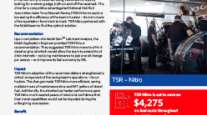Diesel Prices Continue to Fall
By Michael G. Malloy, Staff Reporter
This story appears in the Dec. 8 print edition of Transport Topics.
Diesel fuel prices continued to slide last week, with the U.S. average falling 4.9 cents to $2.615 a gallon, according to the Department of Energy.
The drop left commercial trucking’s main fuel 80.1 cents below the corresponding week of last year and almost $2.15 below the record $4.764 set in mid-July, DOE said following its Dec. 1 survey of fueling stations.
Last week was the first time since late September that the diesel average has fallen by less than a dime, as crude oil price declines have eased.
Plunging oil prices and stronger worldwide inventories of distillate fuels — in part because of lower demand caused by the slowing of economies — have been key factors in diesel’s decline, said Andrew Reed, an oil markets analyst with Energy Security Analysis Inc., in Wakefield, Mass.
“The U.S. produces a small surplus of distillates, so what goes on in other markets often determines our prices here,” Reed told Transport Topics on Dec. 3.
Diesel and heating oil are both distillate fuels, and the relatively mild weather early in the heating season also has helped to keep demand down; the two products’ prices often track together in winter months, Reed said.
Meanwhile, gasoline also continued to fall last week, dropping 8.1 cents to $1.811 a gallon, its lowest level since Jan. 10, 2005, and $2.30 below the high of $4.114 set in July. Gas has fallen in 21 of the past 22 weeks.
With the trucking industry burning about 750 million gallons of diesel and 285 million gallons of gasoline a week, according to American Trucking Associations’ estimates, the weekly cost to the industry has dropped by about $1.6 billion for diesel and $656 million for gas since the record highs in July.
With prices in free fall, analyst Thom Albrecht of Stephens Inc. asked trucking executives at a conference hosted by his firm late last month if they would consider “hedging,” or locking in low prices for diesel going forward.
Several executives balked at such a move.
John Steele, chief financial officer for Werner Enterprises, which ranks No. 13 on the Transport Topics 100 list of the largest U.S. and Canadian for-hire carriers, said his company “has hedged, but very little, and [we] have no plans to do so right now.”
Randolph Marten, chairman and chief executive officer of Marten Transport — ranked No. 47 on the TT 100 — said his company instead is investing in auxiliary power units for tractors to save money.
Stephen Russell, chairman and CEO of Celadon Group, No. 52 on the TT 100, said his company hedged several years ago when oil was at $20 a barrel, only to see it later drop to $10.
On the New York Mercantile Exchange, oil prices closed at $46.96 a barrel on Dec. 2, the lowest price in more than three years, Bloom-berg News reported.
Prices still may go even lower over the next year, Bloomberg reported, despite likely production cuts by the OPEC cartel that could be put in place later this month.
Even if prices start rising again, ESAI’s Reed told TT that oil would likely top out at $60 a barrel, as OPEC’s biggest producer, Saudi Arabia, does not want to risk pushing worldwide economies into deeper recession.
One private fleet executive said last week his company boosted its fuel mileage by 1 mile per gallon, to about 6.3 mpg, by employing a system that uses magnets on fuel lines.
The company bought the systems at about $4,000 per truck six months ago, but “saved almost $10,000 in the first three months on fuel,” said Dennis McStravock, senior buyer for LaMonica Fine Foods, a seafood distributor based in Millville, N.J.
The product, made by Vortex Fuel Systems, helps boost efficiency by altering the fuel’s chemistry as it burns, McStravock told TT.
Steve Elwell, Vortex’s director of sales, told TT that the system lowers the “gel point” of diesel, decreasing the viscosity,” thereby improving efficiency.
Associate News Editor Jonathan S. Reiskin contributed to this article with additional reporting from New York.




